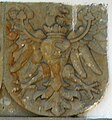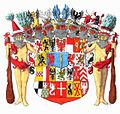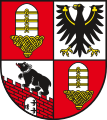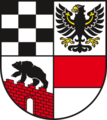Coat of arms of Prussia
The state of
Late Medieval and Early Modern Prussia
-
Imperial Eagle in the coat of arms of the grand master of the Teutonic Order (13th century)
-
Coat of arms of Royal Prussia. From 1772 coat of arms of West Prussia
-
Coat of arms of Duchy of Prussia (1525 –1633) with the letter "S" from Sigismund I the Old
-
Arms of the Duchy of Prussia (East Prussia) from 1545
Kingdom of Prussia
-
Lesser Arms of the Prince-Elector of Brandenburg in 1686
-
Arms of the Prince-Elector of Brandenburg in 1686
-
Prussian arms of 1702
-
Royal arms after a woodcut from 1709
On 27 January 1701, King
The
A decree from 11 February 1701 placed a crown on the Prussian escutcheon. The king ordained that the whole should be placed on a royal pavilion after the French and Danish examples.
When
In 1708 Frederick announced that he would place the quarters of the dukes of Mecklenburg in the Prussian arms to stress his rights to Mecklenburg-Schwerin and Mecklenburg-Strelitz if their ducal lines were to die out. Although Mecklenburg-Strelitz protested, Emperor Joseph I gave permission to Frederick in October 1712. This design was twice officially altered but was not fundamentally changed since.
The electoral scepter had its own shield under the electoral cap. Around the shield, with 36 quarters (including Veere-Vlissingen and Breda), appeared the Order of the Black Eagle with a crowned helmet resting on top. The wild men held banners of Prussia and Brandenburg and behind the pavilion rose a Prussian banner after the example of the French Oriflamme. The motto Gott mit uns ("God with us") appeared on the pedestal.
Already during the reign of Frederick I there is a notable difference between the 'Gothic' representation of the Prussian eagle in the arms and the more naturally depicted and often flying eagle on most coins[4] and military standards.[5]
-
Coat of arms of the Kingdom of Prussia
-
Small arms of 1790
-
"Middle arms" of 1873
-
Greater arms of Prussia, ca. 1873
-
Coat of arms of Prussia 1815
Frederick William I followed his father on the throne on 25 February 1713. According to Ströhl he gave the eagle a scepter and orb. He made an arrangement with the Frisian Nassaus over the title to the Principality of Orange, although it was occupied by France. Besides the arms of Orange, he officially added Veere and Vlissingen on 29 July 1732. The king also added East Frisia to his arms, claiming it in case the prince would die without heir. A fourth escutcheon appeared among the 36 quarters.
Frederick II was followed by his nephew, Frederick William II, on 17 August 1786. Frederick William II inherited the Franconian cadet branches (Ansbach and Bayreuth) of the House of Hohenzollern in 1791. For reasons of economy, however, the official seals were unchanged.
After the fall of Napoleon, Prussia gained extensive territories on the Rhine and in Saxony. New arms were therefore decreed on 9 January 1817. The number of quarters rose to 48, including the horse of Westphalia and Lower Saxony. The number of escutcheons was reduced to four: the black eagle of Prussia, the red eagle of Brandenburg instead of the scepter, the burgraviate of Nuremberg (though ceded to Bavaria), and Hohenzollern proper.
The so-called 'middle arms' were then issued: a shield with the same four escutcheons and ten quarters for Silesia, Rhineland, Posen, Saxony, Pomerania, Magdeburg, Jülich-Cleves-Berg, and Westphalia. This was encircled by the Order of the Black Eagle and held by two wild men with clubs.
The small arms already in use on coins of the 1790s were legitimized as well.
On 7 December 1849, the Swabian lines of Hohenzollern-Sigmaringen and Hohenzollern-Hechingen were annexed by Frederick William IV, who had followed his father on 7 July 1840.
Frederick William IV was followed by his brother
William decreed new arms on 16 August 1873. The number of quarters was again 48 with three escutcheons. Added were the collars of the Order of the House of Hohenzollern and the Order of the Prussian Crown. The motto was placed on the dome of the pavilion.
The middle arms of 1873 show more clearly the changes by the additions of Schleswig-Holstein, Hanover, and Hesse-Kassel and the removals of Magdeburg and Cleves-Jülich-Berg.[6]
-
Coat of arms of the Kingdom of Prussia (1871–1918), in the era of Wilhelm II
The Hohenzollern family uses the
Free State of Prussia
With the fall of the House of Hohenzollern in 1918, the Kingdom of Prussia was succeeded by the
-
Arms of the Free State of Prussia while part of the Weimar Republic (1918–33)
-
Arms of the Free State of Prussia after the 1933 NaziMachtergreifung
Dissolution of Prussia
In 1947, following World War II, the state of Prussia was dissolved by the Allies, thus rendering its arms defunct.
A black eagle on white is present in the arms of Saxony-Anhalt, to stand for what was Prussian Saxony. The Prussian eagle is also featured in the arms of the Salzlandkreis district of Saxony-Anhalt, as well as the former district of Aschersleben-Staßfurt.
A black eagle on red is present in the arms of
-
Arms of Saxony-Anhalt of Germany
-
Arms of Salzlandkreis
-
Arms of Aschersleben-Staßfurt, 1995–2007
-
Arms of the Warmian-Masurian Voivodeship of Poland
See also
- Coat of arms of Germany
- Coat of arms of Austria
- Coat of arms of Brandenburg
- Flag of Prussia
- Iron Cross
- Order of the Black Eagle
- Order of the Red Eagle
References
- Het Spectrum, Utrecht/Antwerp, 1960
- ^ Hubert de Vries, Wapens van de Nederlanden, Uitg. Jan Mets, Amsterdam, 1995
- ^ W.A. van Ham, Wapens en vlaggen van Noord-Brabant, Walburg Pers, Zutphen, 1986
- ^ Gerhard Schön, Deutscher Münzkatalog. 18. Jahrhundert, Battenberg Verlag, Munich, 1984
- ^ Terence Wise, Military Flags of the World, Blandford Press, Poole, Dorset, 1977
- ^ Siebmacher, Großes Wappenbuch, Band 1, 1. Abteilung, 1. Teil, Nuremberg 1856 and 4. Teil, Nuremberg 1921
- ^ "A Royal Student Stein". Steincollectors.org. Archived from the original on 29 June 2011. Retrieved 28 August 2010.





















